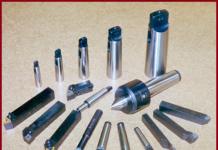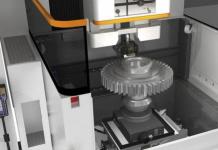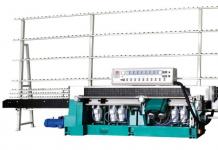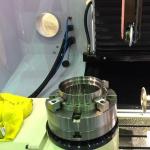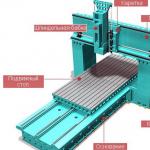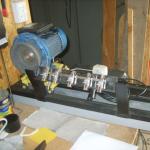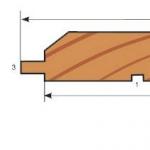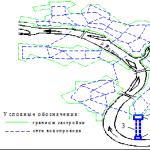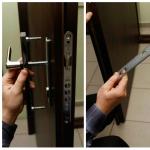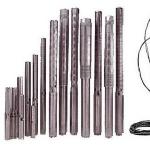Designed to create various products, the shape of which practically does not differ from a given sample. The essence of using these aggregates is that they allow you to create the selected elements in large quantities, while providing high processing speed.
Features of the use of the unit
The milling operation is one of the most common options used in material processing. A copy-milling machine for wood can perform such functions as roughing, semi-finishing or finishing of a shaped and simple surface of workpieces.
This operation is characterized by the fact that it has a very high performance. Thanks to this, this unit allows you to get parts with the correct geometric shape.
Milling methods
In order to carry out this process, one of two existing methods can be used:
- The first method is the up-cut procedure. When using this method, the feed of the element is opposite to the movement of the cutter.
- The second method is climb milling, the essence of which is that the part and the cutter move in the same direction.
As a material for the manufacture of cutters, materials such as mineral ceramics, synthetic, superhard are currently used. However, it is worth saying that the use of such high-quality substances for the manufacture of a cutter can replace the grinding procedure. But this is not very relevant for a wood milling and copying machine, since the material is initially quite soft.
It is also worth noting that there are two types of such machines:
- The first group is general purpose units.
- The second category is specialized devices.
Copy-milling equipment belongs specifically to the second category of machines.
General description of the copy-milling device
A wood milling and copying machine is used to perform copy-type work in volume, as well as on a plane. In addition, the device is also used for work with the use of three-dimensional models. To perform such operations, appropriate copiers are also used.

You can also use this unit to perform the operation of engraving, applying patterns, ornaments or various inscriptions. The greatest advantage of a wood milling and copying machine is that, with its rather simple device, it is capable of performing a wide variety of complex operations.
The essence of the work
It should be noted that the ability of the device to work with different materials depends on the alloy from which the cutter is made. It is possible to carry out operations not only on wood, but also on steel, cast iron, non-ferrous metals. To do this, it is necessary to use carbide as the material for the cutter, as well as provide a high number of revolutions per minute. Such units can be used both for large-scale production and for the manufacture of small batches.
For example, such devices can produce things such as ship propellers, turbojet engines, steam turbines, various shapes, molds, and wood blanks.

It is worth noting that models of a CNC copy-milling machine for wood are produced. The purpose of such devices is to perform the operation of milling curved parts. To accomplish this task, these machines use the copy-to-pattern method. The use of this method helps to eliminate the human factor. This is very important, since a person is not able to create two perfectly identical things, unlike a machine. As a result of the mechanization of the process, that is, the use of machine tools, the possibility of conveyor production of various parts and elements with a curvilinear shape and absolutely the same dimensions has appeared.
Do-it-yourself machine
To date, it is possible to purchase such a device on the market. However, the possibility of creating a home-made milling and copying machine for wood is not excluded.

Since there are quite a few designs of this equipment, its typical, most common form will be presented.
The components of such an assembly are as follows:
- working surface;
- carrier frame or bed;
- milling head.
It is important that the working surface of the equipment has the possibility of height adjustment, and the milling head is equipped with an electric drive. In addition, a two-stage mechanism must be connected to it, the task of which is to provide two different high-speed steps for the operation of the milling head.
A fairly common disadvantage of homemade devices is that they are not able to create an exact copy of the product. The reasons for this are most often jitter, vibration, as well as a change in the direction of the cutter. It will not work to avoid all the flaws, and therefore, in order to minimize their presence, experts recommend creating a narrowly focused equipment model, and not trying to make it universal.
When making a copy-milling machine for wood with your own hands, it is necessary to create a drawing and design all the details in such a way that in the future it will be convenient to work with workpieces of the selected size. For example, there are two types of work - this is milling long workpieces or engraving. These two operations require that the method of fixing the workpiece, like the work surface, be completely different.

This is not the only reason why you need to think everything through in advance. The second thing that everyone who creates a machine on their own will have to face is the choice of an electric motor. Depending on the density of the material with which you need to work, you must select the power of this product. If we talk about working with wood, then most often a motor with a power of 150 to 220 watts is enough.
Another feature that must be observed is the most durable attachment of the copy probe and the device that holds the cutter. These two small details are very important, since the accuracy with which the machine will be able to reproduce the model according to the sample will depend on this.
Milling and copying machine for wood "Duplikarver"
The purpose of this equipment is to perform such operations as woodcarving, copying sculptures and flat relief objects. The main advantage of this particular device is that it has the best price-quality ratio. And its characteristics are suitable for both professional work and beginners.

These devices can carve wood in two ways:
- Volumetric or sculptural carving. This operation is the main one for this machine. It allows you to create exact copies of models from wood materials.
- Flat carving. This type of work includes carving on door panels, panels or any other blanks that have a shallow image depth.
Milling and turning copy machine for wood
The purpose of this type of machine is the processing of wooden products, turning profiles and decorative blanks. A distinctive feature of this kind of equipment is the presence of two incisors at once. One of them is mounted on a steady rest and is intended for processing round wood blanks. This cutter is capable of removing up to 10 mm of material in one pass. The settings for this element are set on a special device.

The second cutter is mounted in a copy carriage, and its main purpose is turning blanks according to the sample. To ensure comfortable work with long elements, the machine has a steady rest that can be attached to the guide rod. It is used as the main support to prevent the long workpiece from bending. It is also possible to install such a part as a faceplate. This allows you to process parts with a large number of faces.
Milling is a type of mechanical processing of materials using a special cutting tool - a milling cutter. The method allows to obtain a high quality of accuracy and the degree of roughness of the treated surface. In addition, it is distinguished by significant performance.
Surface treatment is carried out by up milling, when the rotation of the cutting tool is opposite to the direction of feed, and by climb milling, in which the direction of rotation of the cutter and feed are identical. Using milling cutters with cutting edges made of modern superhard materials, it is possible to replace the grinding operation.
Milling equipment is divided into universal and specialized. In the first case, these are general-purpose machines for performing longitudinal and continuous milling, with and without a tool mounted on a console. In the second - a mechanism for cutting threads, splines, making gears and keyways and milling on a copier.
In production, there is often a need to manufacture several pieces, a batch, or even a series of identical parts. For this, milling equipment equipped with a pantograph is used.
In the household, the functions of a milling machine are usually performed by a manual milling cutter. To perform the maximum list of works, the milling cutter is equipped with a whole set of devices. The main equipment is supplied with the equipment, additional equipment is purchased or manufactured independently. These are a variety of stops, clamps, templates. But you can go even further and make a copier for milling volumetric parts.
Milling and copying equipment: the principle of operation
The principle of operation of such a device is to clearly transmit the movements of the copy head through the holder profile to the cutting tool.
It is quite difficult to buy a copy milling machine, so craftsmen make it with their own hands from improvised materials. Everything happens by trial and error. Therefore, the craftsmen advise first to assemble the duplicarver, and only then to introduce it into mass production. As a rule, this stage is preceded by more than one serious fit and alteration.
Milling and copying equipment: areas of application
On milling copy machines, it is possible to process not only flat, but also volumetric parts. With their help, along with simple milling operations, you can engrave, repeat drawings, patterns and inscriptions. The design of the machine is quite simple, and any master can make it.
Copy-milling machines allow you to process not only wooden parts, but also cast iron, steel and plastic blanks, as well as non-ferrous metal products. This is ensured by high-quality tools made of high-speed steel and hard alloys. The copy machine allows you to mill not only straight, but also curved surfaces. In this case, the details are completely identical.
Milling and copying equipment: design
The typical design of a copy-milling machine is quite simple. It consists of a working table and a system of rails with clips for fastening the router and copier.
Making a universal copy-milling machine at home is quite difficult, and there is no great need for this. For home conditions, equipment with a narrowly focused specialization is usually created.

Making a copy-milling machine: materials
To create a duplicarver at home with your own hands, you should draw an elementary sketch, which will become a guide to further actions. In addition, you need to stock up on some materials. This:
- Knee cemented polished shaft Ø 16 mm.
- Linear bearings in the amount of 2 pcs.
- Rail guides 900 mm long - 2 pcs. For ease of fastening, their length is taken as a multiple of 150.
- Split linear bearings in the amount of 4 pcs. It is desirable to use bearings with a clamping screw to adjust the tightness of the fit on the guide.
- Profile pipe 30×60 with wall thickness up to 3 mm.
- Metal plate 900 long and 100 mm wide.
- End posts in the amount of 2 pcs.
- Movable element in the form of a plate - 1 pc.
- Rocker for attaching a copier and a router - 2 pcs. The length is chosen arbitrarily.
- Movable couplings - 2 pcs.
- Profile pipe 40×40 with wall thickness up to 3 mm.
- Crown clutch for turning workpiece and template.
Making a copy milling machine: tool
After that, you need to prepare a tool that will definitely come in handy for assembling the machine structure. This:
- angle grinder;
- cutting and cleaning disc;
- welding machine;
- welding mask;
- petal disk or brush;
- self-tapping screws for mounting rail guides and movable elements;
- electric drill;
- screwdriver;
- measuring instruments: tape measure, caliper;
- puncher and scriber.
Making a copy milling machine: step by step instructions
After everything is ready, the direct assembly of the copy-milling machine begins.
Step #1
It is necessary to cut two pieces 950 mm long from a profile pipe 30 × 60 for fastening rail guides. A margin of 50 mm is needed to install the limit switches in order to prevent the linear bearings from jumping off.
Step #2
The profile pipe 40 × 40 must be cut into blanks for the base. Guided by the existing sketch, you need to cut off two pieces of 1350 mm and two pieces of 900 mm.
Step #3
From the same pipe it is necessary to cut off small racks. Their linear size depends on the height of the subsequently processed parts.
Step #4
Now you need to remove rust from the pipes. To do this, you can use a petal disc or a brush.
Important! Before using the brush, pay attention to the maximum number of working revolutions on it and the grinder. The value of the speed on the brush must exceed the number of revolutions of the equipment.
Step #5
After that, we scald all the joints and clean the seams with a cleaning wheel 6 mm thick.
Step #6
Then it is necessary to achieve parallelism of rail guides. To do this, you need to make the connection of the rack and the base of the rail guide detachable. It is necessary to take a washer according to the internal size of the rack, weld a nut to it and screw in the bolt. The bolt at this stage is needed in order to install the nut with the washer in the cavity of the pipe-rack flush and in a strictly vertical position, and when welding it, do not damage the thread. You need to do this with all four racks.
Step #7
Racks welded to the base.
Step #8
Holes must be drilled at the base of the rail guide at the junction with the uprights: in the upper shelf for the bolt head, in the lower shelf for the thread.
Step #9
Install the rail guides on the base (pipe 30 × 60), having previously drilled holes, and fasten with metal screws.
Step #10
Mount bases with guide rails and tighten with bolts.
Step #11
Check the parallelism of the guides. If it is absent, it is necessary to make adjustment by placing foil of different thicknesses on the racks under the guide.
Step #12
On a metal plate, you need to mark and drill holes for mounting split linear bearings and end posts.
Step #13
After that, it is necessary to make a movable element by welding rocker arms 300 mm long for a probe and a milling cutter to a metal plate, then attach linear bearings to it.
Step #14
After that, the movable element must be put on a polished shaft, along the edges of which end posts should be installed.
Step #15
The entire structure must be installed on a metal plate 100 mm wide and fixed with self-tapping screws.
Step #16
Then split linear bearings must be installed on the metal plate from the bottom side.
Step #17
After that, the hinged structure is put on the rail guides with split bearings and the limit switches are installed.
Step #18
At the end of the rocker arms, movable couplings are installed and a probe and a milling cutter are attached.
Step #19
In order for the workpiece and the part to rotate synchronously, it is necessary to connect them with couplings. An asterisk and a crown are suitable for control. The copy-milling machine is ready. The design achieved 5 degrees of freedom. Movement along the X axis is ensured by the movement of the structure along the rail guides, movement along the Y axis - by the movement of the movable element along the polished shaft, movement along the Z axis - by the movement of the rocker arms.
Additionally, due to the movable couplings, the probe and the milling cutter can move left and right along the axis of the rocker, and there is the possibility of synchronous movement of the template and the workpiece. This makes it possible to process parts of almost any shape.
Copy-milling machines for metal in mass and serial production
Copy-milling machines for metal are used in mass production. With their help, propellers for ships, turbines of jet engines, pump impellers, dies for forging and pressing production, blanks for mechanical and foundry production are made. In everyday life, metal copiers are practically not used.
Pantograph for milling cutter: design features
To scale copy processes, there is a special device called a pantograph. It facilitates the manufacturing of parts with curved surfaces, allows you to make ornaments and patterns of any complexity in a reduced form. The cost of such a device is quite high. But making a pantograph at home with your own hands is quite realistic.
Pantograph for milling cutter: principle of operation
The schematic diagram of the pantograph looks quite simple. It is a square divided in half. All connections are hinged, so all sides are movable, and the square easily turns into a rhombus when impacted. The zero point, located in one of the corners of the square, is fixed rigidly. Relatively, its design can be modified, turning into a rhombus. A cutting tool is installed in the middle of the square. A copier is fixed diagonally in the opposite corner of the square. The distance from the zero point to the cutter is a certain value A, and to the copier 2A. This gives a scale of 2:1. The linear size of the long and short sides of the pantograph should also differ from each other by 2 times.
Pantograph for milling cutter: materials
In order to make a pantograph with your own hands, you will need the following materials:
- Square metal profile 12×12
- Bearing 180201.
- Bushings for the outer race of the bearing.
- Fingers on the internal size of the bearing and thread M12.
- Nut M12.
- Bolts М6×45
- Nuts M6.
- Bushing for fixing the copier.
- Profile pipe 40×40
- Metal-plastic window hinge.
- Dye.
- Masking tape.
- Metal plate.
- Screw for fixing the copier.
Pantograph for router: tool
In addition to the listed materials, you need a tool:
- Manual frezer.
- Angle grinder.
- Welding machine.
- Spanners.
- Measuring tool.
Pantograph for a milling cutter: step-by-step instructions for making your own hands
We proceed to the direct manufacture of the pantograph.
Stage number 1. cutting blanks
It is necessary to mark and cut a square profile according to the calculated dimensions. For convenience, you can use masking tape and a metal plate. Scotch tape will enable clear marking, and the plate will help to make an even and high-quality cut. The blanks for the site for the milling cutter must be cut at a right angle, and on the sections of the profile for the connecting rods, make a bevel for maximum fit of the bearing sleeve.
Stage number 2. Drilling process holes
On all blanks, it is necessary to chamfer and drill holes Ø 6.2 mm for further connection into the structure.
Stage number 3. Welding a platform for a milling cutter
After that, you need to weld the platform under the milling cutter.
Stage number 4. Making connecting rods
On the board, it is necessary to make a semblance of a conductor and rigidly fix all the parts to be welded. To do this, a hole is drilled in the board, and the bearing in the sleeve is clamped with a bolt, the square profiles of the connecting rods are fastened with clamps. Beforehand, two washers must be inserted between them and fastened with bolts. After that, all joints of the structure are scalded and cleaned. Then you need to cut the bearing bush between the square profiles on each connecting rod. M6 bolts, washers and bearings must be removed. A mount for the router must be welded onto the frame, and an extension for scaling must be welded onto the short connecting rod at the point opposite to zero. The cranks can be painted to give an aesthetic look.
Stage number 5. Making a node for attaching a copier
Now you need to machine two bushings with an inner diameter similar to the size of the copier. On the side, drill a hole and cut a thread to install the screw that fixes the copier. After that, you need to cut off two pieces of a 12 × 12 square 20–30 mm long and weld them on the side between the bushings. The size between the squares should be 12 mm.
Stage number 6. Manufacture of the bearing lifting mechanism
It is necessary to make a bearing lifting unit. To do this, the zero point finger must be welded onto a piece of a 12 × 12 profile and fixed to a 40 × 40 profile pipe using a hinge from a metal-plastic window. The profile pipe will serve as a place for attaching the pantograph to the table with a clamp.
Stage number 7. Pantograph Assembly
The bearings must be installed in the bushings and securely fastened by tightening the square profiles of the connecting rods with M6 bolts. With the help of fingers, it is necessary to assemble the connecting rods into a single structure. Fix the pantograph on the table with a clamp and install the router. The device is ready to work.
Cutting tool for milling work: copy cutters
Copy cutters are a tool on which, in addition to the cutting part, there is a bearing. Its size is equal to the diameter of the cutting part of the cutter. The bearing can be located both in the upper and lower part of the cutter. This is how the tool is classified. It is worth considering that the marking means the position of the bearing with the usual placement of the cutter - shank up.
They serve to perform copy work on a template. When using a cutter with an upper bearing, the template is located on top of the part, if with a lower bearing position, then from below.
Work with a manual milling cutter involves the use of any cutters. It is safe. The only thing is that when using a cutting tool with a top bearing, you should pay attention to the overhang of the cutter so as not to damage the workbench.
Milling on a woodworking machine involves the use of cutters with only the lower position of the bearing. This is due to the fact that in a cutter with an upper bearing position, the open rotating cutting part is in the area of the workpiece. Careless movement can result in serious injury. Such cutters are used on machines only in special cases with maximum compliance with safety regulations.
Copy-milling machines are unique equipment with the help of which the most complex work on the manufacture of identical parts is carried out. But for work at home, you can make simple analogues of such equipment and devices that will help in everyday life or a small business.
Products made of wood are distinguished by their uniqueness and environmental friendliness, which is why they are so appreciated. But to make a wooden masterpiece with your own hands without a manual milling cutter will not work. In addition, it will need devices with which the craft takes on a given shape.
They can even be made with your own hands, and special forces and skills are not required. Before working with a router, you must first familiarize yourself with each of these devices, as well as learn how they work. In the article, we will consider the most necessary designs for a milling cutter.
Device - parallel stop
This device, as a rule, is already sold with a router. Therefore, there is no need for its independent development and creation. For a reliable stop of the processed material, this element is used. With it, the movement of the cutter becomes rectilinear relative to the base surface, which can be a table guide, rails or straight edge detail.
Such a device makes it possible to quickly mill a variety of grooves and edge processing, holding the material firmly.
Guide bar
If you need to make a straight cut with a router, then you can not do without this device. To make it, you need any flat board, for example, you can use a piece of chipboard.
First you need to find out the distance from the edge of the milling base to the center of rotation, and it is always the same. To do this, screw a guide to the unnecessary part of the material and make a trial cut. Then you should measure the gap from the edge of the cut to the tire, to which the radius of the cutter is added. As a result, it will be possible to obtain the required value. For example, it is 59 mm, and the diameter of the groove cutter is 14 mm, that is , its radius is 7 mm.
Then you should draw a line under the cut, from which we retreat a distance of 52 mm (59-7), and draw another one. On it we fix the guide and carry out the cut.
Circle milling
For such purposes, use compasses. With their help, the milling cutter can move in a circle. The simplest of these is a device consisting of a rod, one end of which is equipped with a screw with a pin, and the other is fastened to the base of the tool. Of course, it is better to use a compass equipped with two rods.
In general, there are many branded and even home-made devices for cutting circles for a router, which differ from each other in ease of use and dimensions. Quite often, compasses have a mechanism changing the radius of the circle. As a rule, it is a screw with a pin at the end, moving along the groove of the router.
When it is necessary to mill a small circle, the pin should be located under the base of the tool. In these cases, other devices are also used, which are fixed down to the base of the device.
But for cutting circles, it is not necessary to buy a milling compass. Instead, you can use a parallel stop. To do this, the device is attached to the groove on the sole. A screw is screwed into it, which is recommended to be equipped with a sleeve so that its diameter matches the size of the hole. That's all the compass is made. The radius can be adjusted with a stop.
Devices for replication and copying
 To create a series of identical products use:
To create a series of identical products use:
- Angle lever;
- Copy sticks.
There is a scale on the angle lever, the division value of which is 1/10 mm. It allows you to center the stop ring under the cutter, which helps to accurately reproduce the shape of the part on the workpiece during copying. It is often equipped with a chip guard and a support plate for the best edge finish.
Using copy templates and rings
Copy rings - a round plate with a protruding rim that slides along the base surface along the template. Such a device provides an accurate path for the movement of the cutter. Basically, this element is installed to the sole of the workbench. At the same time, there is several ways to mount it:
- Installation of special antennae in the holes on the sole;
- Screwing the ring into a threaded recess.
The use of a template also allows you to achieve more efficient and accurate work. It is attached directly to the workpiece with double-sided tape, and then both parts of the fixture are pressed to the machine with clamps. Moreover, experienced millers are advised to check how tightly the ring is pressed against the edge of the template.
In addition, with such a device, it is possible to process not the entire edge, but only the corners. Hence, pattern processing procedure- an excellent option for cutting grooves for the product.
Dust extractors
 Professional craftsmen, in order to ensure dust removal, specially buy a technical vacuum cleaner, which is connected via an adapter with a hose to the router. Moreover, it does not interfere with the control of the tool, and the marking and the place of processing of the product are always open for visual inspection.
Professional craftsmen, in order to ensure dust removal, specially buy a technical vacuum cleaner, which is connected via an adapter with a hose to the router. Moreover, it does not interfere with the control of the tool, and the marking and the place of processing of the product are always open for visual inspection.
It is very difficult to work without a suction unit. But not everyone decides on such a purchase, since it is too burdensome in terms of money, and besides, it is not always justified. True, there is another solution, you can get rid of dust with a household vacuum cleaner.
Between the milling machine and the vacuum cleaner are installed sealed tank. He will capture the bulk of the dust. It is equipped with an additional hose, and a fabric mesh is inserted inside. Moreover, these designs can be purchased ready-made or do it yourself. By the way, a home-made device will help to collect even large construction debris and wood dust with a household vacuum cleaner.
Slot milling device
Such a device is used for processing longitudinal grooves on poles, balusters and other bodies of revolution. The principle of its work is the following. A baluster is installed in the body and fixed. With the help of a locking screw and a disk, the workpiece is fixed in a strictly defined position.
After that, the carriage is set in motion, and the milling a groove along the length of the product. Then the part is unlocked, rotated to the required angle, locked and the next groove is created.
Woodcarving instructions with a milling cutter
For novice craftsmen, working with a hand tool may seem difficult, since the process of controlling it seems difficult. That is why, before you start milling, you need to familiarize yourself with the principle of its operation.
Router Assembly
The first step is to check the place of attachment of the cutter in the machine, as a rule, a collet chuck is used for this. First you need to select the desired cutter that matches the size of the cartridge. If necessary, you can replace it.
But when deep machining is required, a version with an extended shank is used, which is inserted into the chuck hole and secured with a key. This must be done carefully without applying force, otherwise you will pinch, which is not the norm for the router to work correctly. Although it is worth trying to reach a good stop so that the cutter does not stagger. It remains only to clamp the spindle lock and you can proceed to work.
After that, the router turns on, you need to get used to the sound and feel the start. Often, it is because of surprise that many begin to make a marriage.
Depth Selection
 In addition, you will need to install a milling depth limiter. First, the machine is applied to the product from the edge, while the cutter should not come into contact with the material. It will have to be pressed until it reaches the required depth, after which position is fixed.
In addition, you will need to install a milling depth limiter. First, the machine is applied to the product from the edge, while the cutter should not come into contact with the material. It will have to be pressed until it reaches the required depth, after which position is fixed.
For a more accurate value, a stepwise limiter is used. You can find out its step in the manual for the router. In this case, the knob turns to the desired number of degrees.
First of all, the required speed is determined. This is done according to the table in the instructions, based on the diameter of the cutter and the material being processed.
If you have never worked with a router before, then it is better to try your hand at a draft version. In addition, it will help to set the desired parameters. directly in processing mode.
It is also desirable to compare the results after the tool has moved clockwise and counterclockwise, towards itself and away from itself. When milling a product around, the correct direction is counterclockwise, and on its flat side, on the contrary, away from you. Then you can already start carving the main workpiece.
Copy-type equipment is used in cases where it is necessary to manufacture parts according to a specific template within a small batch. In some cases, a copy-milling machine is used under conditions of large-scale production, like the CNC variety. This is due to the fact that the machine in question is capable of creating products, the shape of which is most consistent with the original sample, like CNC machines, the movement of the cutter is set automatically. The main feature that the copy-milling machine has is high processing speed.
purpose
Often, a key-cutting machine is used to perform volumetric and flat work, its operation is similar to the options that have a CNC system installed. At the same time, special models allow wood processing by volume, when a three-dimensional model is used as a copier. In the field of woodworking, processing by volume allows:
- create ornaments and various inscriptions.
- engrave shaped profiles.
- create complex patterns, the faces or planes of which are located in different planes.
The woodworking machine in question is often used in the furniture industry. Many decorative parts that have a complex shape are created using a similar machine.
Principle of operation
The possibility of significantly accelerating the production process of complex products is determined by the features of the work that the copy-milling machine has. As with metalworking, woodworking uses a cutting tool called a "milling cutter".
The main points of work can be called:
- The cutter creates a contour or surface, which are set using a copier.
- The link between the cutting tool and the tracking device is a mechanical, hydraulic, pneumatic system. The woodworking machine most often has a mechanical feed and control system.
- A flat template, a previously created reference model, a spatial model, a photocell, a contour drawing can serve as a copier. In some cases, these machines are equipped with CNC, which makes them widely versatile.
- Samples serving as a template may be made of metal, wood, plastic or other material.
The copy-milling machine works as follows: a sample of various types is installed, a tracking device is supplied to it, which, through a certain type of connection, transmits the necessary force to the cutting tool.
Classification
- wood pantograph for milling cutter. this option can work in 2 or 3 dimensions;
- universal type, which is also called as a pantograph, having a swivel sleeve. as a rule, the sleeve is located in a vertical plane;
- there are execution options that have several spindles to speed up the processing process;
- with mechanical, electrical, hydraulic feed;
- photocopying view of the transfer of the contour for the direction of the cutting tool.
There are many schemes according to which you can create a copy-milling machine with your own hands. A typical variant usually consists of the following elements:
- Desktop;
- carrier frame;
- milling head.
To carry out the procedure for changing the cutting mode, the height of the table is changed, the head with the cutter has an electric drive that sets the cutting tool in motion, often a transmission mechanism for changing speeds is included in the system.
The pantograph itself can be made as follows:
- From a tree. You can create such a pantograph with your own hands, but at the same time it will have low processing accuracy, since the wooden parts are connected using a loop. Fastening with a loop is characterized by backlash.
- Drawing pantograph made of metal - allows you to create copies at various scales, but cannot be used to create three-dimensional copies.
When creating a machine with your own hands, it should be noted that many parts may have flaws and mismatch in size. This situation is associated with vibration and trembling of the base, which is quite difficult to avoid. When changing the direction of movement of the cutter, errors are also possible. Due to the internal stress of the wood workpiece, the workpiece may warp. Therefore, it is recommended to create such equipment only for narrow-profile production, when the machine will be designed to create one part. It is almost impossible to avoid the problems under consideration, however, if the same part is processed, a gradual improvement in the design is possible.
For full-fledged work with a manual router, in addition to the tool itself, the material and the corresponding set of cutters, it is necessary to have one more component - fixtures. In order for the cutter to form the workpiece in accordance with the master's intent - cutting the material exactly where it is required - it must be in a strictly defined position relative to the workpiece at any given time. To ensure this, numerous devices for a manual milling cutter serve. Some of them - the most necessary ones - are included in the instrument delivery set. Other milling devices are purchased or made by hand. At the same time, home-made devices are so simple that for their manufacture you can do without drawings, using only their drawings.
Parallel stop
The most used device, which comes with the kit for almost every router, is a parallel stop, which ensures the rectilinear movement of the cutter relative to the base surface. The latter can be a straight edge of a workpiece, a table or a guide rail. The parallel stop can be used both for milling various grooves located on the face of the workpiece, and for processing edges.Parallel stop for a manual router: 1 - stop, 2 - rod, 3 - router base, 4 - rod stop screw, 5 - fine adjustment screw, 6 - movable carriage, 7 - movable carriage stop screw, 8 - pads, 9 - screw stop stop.

To set the device in working position, it is necessary to push the rods 2 into the holes of the frame 3, providing the necessary distance between the support surface of the stop and the axis of the cutter, and fix them with the locking screw 4. For precise positioning of the cutter, you need to release the locking screw 9 and turn the fine adjustment screw 5 set the cutter to the desired position. For some models of the stop, the dimensions of the supporting surface can be changed by shifting or expanding the support pads 8.
If one simple part is added to the parallel stop, then with its help it is possible to mill not only straight, but also curved grooves, for example, to process a round workpiece. Moreover, the inner surface of the bar located between the stop and the workpiece does not have to have a rounded shape, repeating the edge of the workpiece. It can also be given a simpler form (Figure "a"). In this case, the trajectory of the cutter will not change.

Of course, the usual parallel stop, thanks to the recess in the center, will allow you to orient the router along the rounded edge, however, the position of the router may not be stable enough.
The guide bar is similar in function to the rip fence. Like the latter, it provides a strictly rectilinear movement of the router. The main difference between them is that the bar can be set at any angle to the edge of the workpiece or table, thus providing any direction of movement of the router in the horizontal plane. In addition, the tire may have elements that simplify the performance of certain operations, for example, milling holes located at the same distance from each other (with a certain step), etc.
The guide rail is attached to the table or workpiece with clamps or special clamps. The tire can be equipped with an adapter (shoe), which is connected to the base of the router with two rods. Sliding along the profile of the tire, the adapter sets the rectilinear movement of the cutter.
Sometimes (if the distance of the tire from the router is too close), the bearing surfaces of the tire and the router may be in different planes in height. To align them, some routers are equipped with retractable support legs that change the position of the router in height.
Such a device is easy to do with your own hands. The simplest option is a long bar fixed to the workpiece with clamps. The design can be supplemented with side stops.

By placing a bar on two or more aligned blanks at once, they can be grooved in one pass.

When using a bar as a stop, it is inconvenient to place the bar at a certain distance from the line of the future groove. This inconvenience is devoid of the following two devices. The first is made from boards and plywood fastened together. In this case, the distance from the edge of the stop (board) to the edge of the base (plywood) is equal to the distance from the cutter to the edge of the router base. But this condition is met only for a cutter of the same diameter.. Thanks to this, the device quickly aligns with the edge of the future groove.

The following fixture can be used with cutters of different diameters, plus when milling, the router rests with its entire sole, and not half, as in the previous fixture.


The stop is aligned along the edge of the hinged board and the center line of the groove. After fixing the stop, the folding board leans back, making room for the router. The width of the folding board, together with the gap between it and the stop (if any), must be equal to the distance from the center of the cutter to the edge of the router base. If you focus on the edge of the cutter and the edge of the future groove, then the device will work with only one cutter diameter.
When milling grooves across the fibers, at the exit from the workpiece, when milling an open groove, cases of wood scuffing are not uncommon. The following devices will help minimize scuffing, which press the fibers at the exit of the cutter, preventing them from chipping off the workpiece.


Two boards, strictly perpendicular, are connected with screws. Different cutters are used on different sides of the stop so that the width of the groove in the fixture matches the width of the groove of the part to be milled.
Another open slot milling fixture can be pressed tighter against the workpiece to further minimize burrs, but it only fits a single diameter cutter. It consists of two L-shaped parts connected on the workpiece with clamps.


Copy rings and templates
A copy ring is a round plate with a protruding collar that slides along the template and provides the necessary trajectory for the cutter. The copy ring is attached to the sole of the router in various ways: it is screwed into a threaded hole (such rings are in the photo below), the antennae of the ring are inserted into special holes on the sole or screwed.

The diameter of the copy ring should be as close to the diameter of the cutter as possible, but the ring should not touch the cutting parts of the cutter. If the ring diameter is larger than the cutter diameter, then the template must be smaller than the finished parts to compensate for the difference between the cutter diameter and the copy ring diameter.

The template is fixed on the workpiece with double-sided tape, then both parts are pressed with clamps to the workbench. When you have finished milling, check that the ring is pressed against the edge of the template during the entire operation.
You can make a template for processing not the entire edge, but only for rounding the corners. In this case, using the template shown below, it is possible to make roundings of four different radii.


In the figure above, a cutter with a bearing is used, but the template can also be used with a ring, only either the ring must exactly match the diameter of the cutter, or the stops should make it possible to move the template away from the edge by the difference in the radius of the cutter and the ring. This also applies to the simpler version shown below.


Templates are used not only for milling edges, but also for grooves on the plate.

The pattern can be adjustable.


Template milling is a great method for cutting grooves for hinges.


Devices for milling round and elliptical slots
Compasses are intended for the movement of a milling cutter on a circle. The simplest device of this type is a compass, consisting of one rod, one end of which is connected to the base of the router, and the other has a screw with a pin at the end, which is inserted into the hole that serves as the center of the circle along which the cutter moves. The radius of the circle is set by the displacement of the rod relative to the base of the router.
It is better, of course, that the compass was made of two rods.

In general, compasses are a very common device. There are a large number of branded and home-made devices for circumferential milling, differing in size and ease of use. As a rule, compasses have a mechanism that provides a change in the radius of the circle. Usually it is made in the form of a screw with a pin at the end, moving along the groove of the device. The pin is inserted into the center hole of the part.



When it is necessary to mill a circle of small diameter, the pin must be located under the base of the router, and for such cases other devices are used that are attached to the bottom of the base of the router.

Ensuring the movement of the cutter in a circle using a compass is quite simple. However, one often has to face the need to perform elliptical contours - when inserting mirrors or oval-shaped glasses, arranging arched-type windows or doors, etc. Device PE60 WEGOMA (Germany) is designed for milling ellipses and circles.


It is a base in the form of a plate, attached to the surface using vacuum suction cups 1 or screws, if the nature of the surface does not allow fixing with suction cups. Two shoes 2, moving along intersecting guides, ensure the movement of the router along an elliptical path. When milling a circle, only one shoe is used. The fixture kit includes two mounting rods and a bracket 3, with the help of which the router is connected to the plate. The grooves on the bracket allow you to install the router in such a way that its supporting surface and the base of the plate are in the same plane.
As you can see from the photos above, the milling cutter was used instead of a jigsaw or band saw, while, due to the high speed of the cutter, the quality of the machined surface is much higher. Also, in the absence of a manual circular saw, the router can replace it.
Devices for milling grooves on narrow surfaces
Grooves for locks and door hinges, in the absence of a milling cutter, are performed using a chisel and an electric drill. This operation - especially when making a groove for an internal lock - takes a lot of time. Having a milling cutter and a special device, it can be done several times faster. It is convenient to have such a fixture that allows milling slots of a wide range of sizes.To make grooves in the end, you can make a simple fixture in the form of a flat base attached to the sole of the router. Its shape can be not only round (according to the shape of the base of the router), but also rectangular. On both sides of it, you need to fix the guide pins, which will ensure the rectilinear movement of the router. The main condition for their device is that their axes are in line with the center of the cutter. If this condition is provided, the groove will be located exactly in the center of the workpiece, regardless of its thickness. If it is necessary to move the groove to one side or another from the center, a bushing with a certain wall thickness must be put on one of the pins, as a result of which the groove will shift in the direction from which the pin with the bushing is located. When using a router with such a device, it must be driven in such a way that the pins are pressed on both sides to the side surfaces of the part.

If you attach a second parallel stop to the router, you will also get a device for milling grooves in the edge.

But you can do without special devices. For the stability of the milling cutter on a narrow surface, boards are fixed on both sides of the part, the surface of which should form a single plane with the surface to be machined. When milling, the router is positioned using the parallel stop.

You can make an improved version that increases the area of \u200b\u200bsupport for the router.


Device for processing balusters, pillars and other bodies of revolution
The variety of work that is performed by a manual milling cutter sometimes dictates the need for independent manufacture of devices that facilitate the performance of certain operations. Branded devices are not able to cover the entire range of work, and they are quite expensive. Therefore, home-made fixtures for a router are very common among users who are fond of working with wood, and sometimes do-it-yourself fixtures either outperform branded counterparts or have no branded counterparts at all.Sometimes there is a need to mill various grooves in the bodies of revolution. In this case, the device shown below may be useful.




The device is used for milling longitudinal grooves (flutes) on balusters, poles, etc. It consists of a body 2, a movable carriage with a milling cutter 1, a disk for setting the angle of rotation 3. The device works as follows. The baluster is placed in the body and fixed there with screws 4. Turning to the desired angle and fixing the workpiece in a strictly defined position is provided by disk 3 and locking screw 5. After fixing the part, the carriage with the router is set in motion (along the guide rails of the body), and milling a groove along the length of the workpiece. Then the product is unlocked, rotated to the required angle, locked and the next groove is made.
A similar fixture can be used instead of a lathe. The workpiece must be slowly rotated by an assistant or a simple drive, for example, from a drill or a screwdriver, and excess material is removed by a milling cutter moving along the guides.
Stud milling fixtures
Tenon cutters are used for milling the profile of tenon joints. In the manufacture of the latter, greater precision is required, which is almost impossible to provide manually. Tenoning devices allow you to quickly and easily complete the profile of even complex joints such as dovetails.
The figure below shows an industrial sample of a tenoning device for the manufacture of three types of connections - "dovetail" (deaf and through version) and through connection with a straight tenon. Two mating parts are installed in the fixture with a certain shift relative to each other, controlled by pins 1 and 2, then they are processed. The exact path of the cutter is set by the shape of the groove in the template and the copying ring of the router, which slides along the edge of the template, repeating its shape.




When using the content of this site, you need to put active links to this site, visible to users and search robots.
